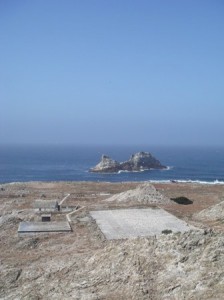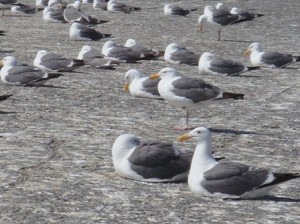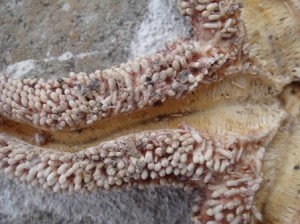So, the last couple of days have been pretty uneventful as far as things go. Without night work and extra work, we’ve all just been enjoying having a routine that actually falls together nicely, as well as the free time to watch a movie last night (for the first time in about two weeks!).
The final (??) film crew for the season arrived and left today, taking high definition pictures for a display about the Farallones at the California Academy of the Sciences. In addition, a couple of grad students working with Ashy Storm Petrels came out to install some equipment for a pilot project they’re doing. I didn’t have to help with the boat landing, but I did help with the boat launch, so I got to talk to them all for a little bit, but mostly I wasn’t affected by them being here.
Made dinner last night–falafel and Greek Egg Lemon Soup. It was a hit, I think, and all the leftovers are already gone. Today, the Superfish (the boat that brought out the film crew, etc.) caught us some rockfish and filleted it, so we’re cooking up rockfish fillets. I’ve said I’ll taste it, but fish are really not my thing, and Caitie is making Jordan and me a vegetarian option anyway, so we’ll see how it goes.
So, because of the lack of news and exciting pictures, I thought I’d write a little bit about how we get our water on the island, because it’s so important out here! Up until not that long ago, the Coast Guard actually delivered water to the island, in drums, but at a certain point, everyone realized that wasn’t a very practical system.
Scattered around the island are old water tanks, I think there are four of them, but we don’t use them anymore. In fact, the areas of the old water tanks are some of the ones that tested highest for soil contaminants in the recent Fish and Wildlife study. The old tanks are really falling apart now, and are full of holes and guano, so we wouldn’t want to use them anyway.
These days, all of the water we use for drinking, showering, washing dishes, and everything comes from the winter rain storms. In this picture, you can see our large catchment pad (the rectangular area on the right), where water collects and is funneled down into the storage basin at the left. Once in the storage container, it goes through six levels of filtration, and there is one tap in the house that goes through a seventh. All of the tap water in the house is safe for drinking, but the toilets are now on a closed gray water system, which is far more efficient than the old system.
One thing to notice about the catchment pad is that it is just like everything else on the island–covered with guano. So, obviously, no water is collected during seabird season, not that it rains anyway.
It’s up to the winter biologists and crew to scrub the catchment pad clean before the winter rains begin, and I suppose we’re trusting that they did a good job last year. It must be quite a difficult task scrubbing this pad clean enough to supply the island with drinking water! But, we don’t seem to be having any issues with water supply or availability, which is excellent, because it means we each get to shower once every four days.
Finally, I’ll end with a picture of a starfish I found today. I thought it was very pretty, though I don’t know how it got all the way up to the steps of the house. Probably a gull brought it. They bring all kinds of things, which we call “gull juju.” For example, yesterday I found a bracelet made out of star-shaped beads which was almost certainly regurgitated by a gull who ate it on accident.
Best,
Eleanor




